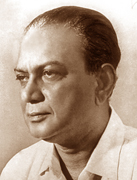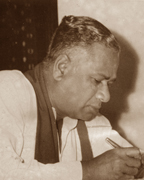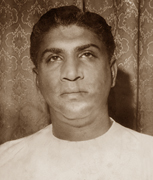Achievements of 1956-59 MEP regime and conflicts within
by W.T.A. Leslie FERNANDO
 |
|
Maithripala Senanayake |
The 1956-59 MEP government set about a social revolution in Sri
Lanka. First and foremost it declared the May Day - the International
Worker's Day, a holiday in our country.
Thereafter on June 6, the MEP government passed the resolution that
made Sinhala, the official language in Sri Lanka. The UNP too voted in
favour of it and only the Tamil parties with LSSP and the CP voted
against it. By making Sinhala the official language, the rightful place
was given to Sinhala, that was dethroned after the British conquest in
1815.
Prof. Mendis Rohanadeera explains that for 2,300 years Sinhala had
been the State language in Sri Lanka, except for 53 years from 1017 to
1070, when Sri Lanka came under Chola domination. Getting the due place
to Sinhala was the culmination of the struggle carried on for 140 long
years by the people in Sri Lanka against the imperial domination.
There are some who contend that making Sinhala the official language
was the beginning of the ethnic conflict in our country. Nevertheless
this was a step broadly paralled to similar ones taken in post-colonial
countries. Thus India made Hindi the official language while allowing
regional languages such as Tamil to be used locally. It is not gainsay
that the failure of successive governments to implement at least the
provisions of the Reasonable Use of Tamil mooted, widened the gap
between the Sinhalese and the Tamils in Sri Lanka.
On the other hand making Sinhala the official language brought about
a social revolution in Sri Lanka. Prior to thereat all the high
appointments, job opportunities and other privileges were the
prerogative of the elite and opened only to the English educated who
were only 05% of the population. All those avenues were open to the
commoners only after making Sinhala the official language.
 |
|
C.P. de Silva |
Before 1956, the foreign policy of Sri Lanka was to follow the
dictates of the West. In 1955 the UNP government did not allow Soviet
scientists to come to Sri Lanka to observe the eclipse of the Sun. The
MEP government followed a non-aligned foreign policy and opened up
diplomatic relations with countries like Soviet Russia and Communist
China. It also abrogated the Defence Agreement with the British.
In 1957 Vidyodaya and Vidyalankara Pirivenas were made Universities.
As a result erudite Maha Theras like Welivitiye Soratha, Bambarande Siri
Seevalee, kalukondayawe Praggnaskera, Yakkaduwe Pragnarama, Kotahene
Pragnakiththi and Kiriwaththuduwe Praggnasara came to the forefront. For
the first time a separate Ministry was formed for cultural affairs and
there was a renaissance in indigenous culture.
The MEP government did a lot for the betterment of the commoner. The
Paddy Lands Act and the Multi-Purpose Co-operatives benefitted the
peasant. Labour Tribunals were set up to bring relief to workers. It was
the MEP government that nationalised the bus transport and the Port. The
mechanisation of the fishing industry too was effected in this regime.
The year 1956 was a landmark in other aspects as well. It was in 1956
that Martin Wickremasinghe released his classic 'Viragaya' Prof. E.R.
Sarathchandra staged his epock-making 'Maname' and Lester James Peiris
screened ground-breathing 'Rekawa'. W.D. Amaradeva in the field of
Music, Chithrasena, Premakumara and Panibharatha in dancing too were
given their due places. In the 1956-59 MEP government, the two Leftist
ministers, Philip Gunawardena and William de Silva of the VLSSP forged
ahead with a radical agenda. Philip introduced the Paddy Land Act to
emancipate the tenant farmer. His Multi-Purpose Co-operative scheme was
meant to facilitate proper distribution of produce to ensure benefits to
both the producer and the consumer.
 |
|
Stanley de Zoysa |
Philip re-generated agriculture with modern techniques and
re-planting programmes to increase the yield. He re-activated the
co-operative movement for the benefit of the consumer. Ministry of
Agriculture and Food in a hectic three years under Philip Gunawardena
borough change and growth virtually to every subject that came under its
purview.
P.H. William de Silva as the Minister of Industries and Fisheries
also did a yeoman service to the country. The mechanisation of fishing
industry was begun under him and as a result fish landings increased in
great proportion. For the first time he introduced a concerted policy
for the development of industries in our country. During his tenure of
office various corporations like steel, tyre, flour milling and mineral
sands were set up and while encouraging various incentives saw the
beginning of many private industries.While the Minister of Transport
Maithripala Senanayake sought to postpone the process for eight years,
pressure from Philip, William de Silva and other progressive Ministers
saw the bus transport nationalised in 1958. It is now generally
acknowledged that Philip's group was responsible for most of the
progressive measures instituted in the 1956-59 regime?
In due course there developed a conflict between the progressive
Ministers and reactionaries in the MEP Cabinet. Philip Gunawardena,
William de Silva and T.B. Illangaratna led the progressive camp. W.
Dahanayaka, C.P. de Silva, Maithripala Senanayake, R.G. Senanayake and
Stanley de Zoysa were the leaders of the reactionary group.
The Catholic Church in Sri Lanka took measures to strengthen the
reactionary elements. They got round W. Dahanayake, the Minister of
Education who was at one time a teacher at St. Aloysious College, Galle.
He was one of the protagonist of the reactionary group in the MEP
Cabinet. It was a demand all over the country that all the assisted
schools should be vested in the State. Dr. W. Dahanayake as the Minister
of Education indicated that he would not 'take over' the assisted
schools.
 |
|
R.G. Senanayake |
The Catholic priests who made a big noise about 'Social Justice' in
the 1940's did every thing possible to sabotage the Free Education
Scheme and failed. Likewise the same crowd of priests rigorously
campaigned against the Paddy Lands Act that brought relief to the tenant
farmer. In fact some students of Aquinas College of Higher Studies who
at the instigation of such priests distributed pamphlets against the
Paddy Lands Act were chased away by harbour workers.
During this time there was a conspiracy by the Catholic top brass in
the police force against Osmund de Silva, a good Buddhist who acted
impartially at the 1956 general election to oust him from the post of
IGP. They succeeded and as a result M.W. Abeykone was appointed as the
IGP. At this stage Philip Gunawardena realised that there was a
conspiracy against the government. However the first to disclose this in
Parliament was Dr. N.M. Perera. In the MEP May Day rally in 1959 Philip
Gunawardena revealed that the senior DIG Sydney de Zoysa was conspiring
against the government and requested the Prime Minister S.W.R.D.
Bandaranaike to remove him immediately. Philip had to face a criminal
defamation case over this issue.
In the first half of the year 1959, the conflict in the Cabinet
worsened. When Philip introduced the Co-operative Development Bank Bill,
the Cabinet Ministers in the reactionary camp opposed it vehemently.
Prime Minister Bandaranaike wanted to introduce the Bill himself to
bring about a settlement and Philip too agreed. Nevertheless the
reactionary Ministers initiated a Cabinet strike and insisted that they
would not attend the Cabinet meetings until Philip Gunawardena is
removed.
Prime Minister S.W.R.D. Bandaranaike was helpless and he envisaged
the LSSP to join the Cabinet and strengthened the progressive camp. At
one time Dr. N.M. Perera and few leaders of the LSSP took up the
position that the MEP regime in spite of its shortcomings was a
socialist government and its weakening would lead to the rise of
reaction. They were opposed by the militants in the LSSP like Edmud
Samarakkody, Robert Gunawardena and J.C.T. Kotelawala. As such the LSSP
did not come to the rescue of S.W.R.D. Bandaranaike.
In this background as a measure to get out of the situation, Prime
Minister Bandaranaike wanted to reshuffle the Cabinet by removing the
subject of Co-operatives from Philip's Ministry and Fisheries from that
of William de Silva.
Philip was to be allocated Fisheries in addition to Agriculture and
Food. The two Ministers, Philip and William de Silva however resigned
from their portfolios in protest and joined the opposition. In all 12
members of the government all of the VLSSP and 7 from the SLFP crossed
over to the opposition with them. That was the end of the MEP Cabinet
and a sole SLFP Government was formed.
|

